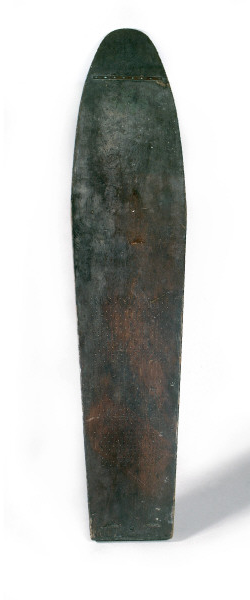Oregon Redwood Surfboard
Posted: November 1, 2015 at 6:57 am

- This solid Oregon redwood, square tailed surfboard features a round nose and an 18 mm hole located at the centre of the tail designed to accommodate a leg rope. A metal strip has been screwed onto the board near the nose to prevent splitting, and the bottom of the board has an unusual ‘v’ plateau. The deck has a series of punch or drill holes, which were added for grip, and two crescent-like grooves acting as hand-grips on either side of the rope hole. The surfboard’s original green insignia has been painted over with the letters ‘EN’, the original owner’s initials. Ernie Newberry was a member of Wander Beach Surf Life Saving Club, and used to drag the heavy board from his home in Cronulla to Wanda Beach.
- Though Australia was first introduced to surfing in the late 19th century by traders and travellers who had passed through Hawaii, the surfing demonstration of Hawaiian Duke Kahanamoku at Freshwater Beach in 1914 was a significant moment in Australia’s surfing history. Solid hardwood planks were common on Australian beaches between World War I and World War II, and pre-dated the Australian surfing boom of the late 1950s and early 1960s. Designs were often similar to the Duke’s 1914 board, which was shaped from sugar pine purchased from Hudson’s Timber Mill in Sydney, and incorporated many of the standard Hawaiian design characteristics. Wooden boards were covered in layers of varnish, oil or shellac to prevent the board from becoming waterlogged. They were finless until the early 1950s, and often featured a brass or copper band or sheet fitted to the nose to prevent the wood from splitting. Redwood was recognised as being tough and durable, though much lighter boards in balsa and plywood were also popular.Info courtesy Trove.
Posted in General
